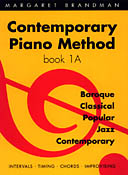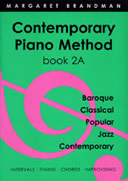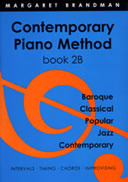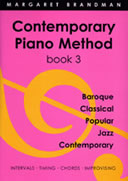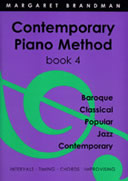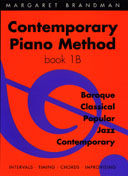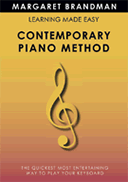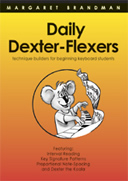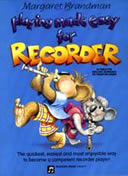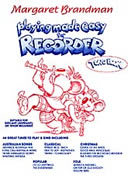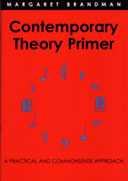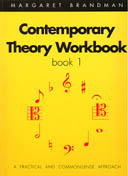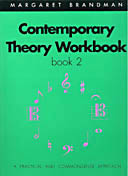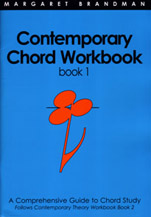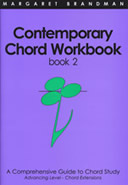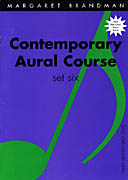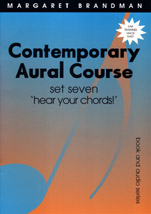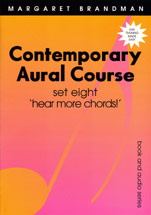
 |
EDUCATIONAL MATERIALS
Brandman
Music Education materials for use with AMEB 'Music Craft'
topics:
|
| Pictorial Patterns is a unique book which allows pianists to learn scales by understanding keyboard geography rather than relying on notation. Through being able to view hand shapes on the keyboard patterns the fingering for scales is simplified and mirror fingerings can be seen. Equally useful for students of classical or modern piano, and for improvisors, it shows both similar and contrary motion patterns and all major and minor chord shapes. In three sections:
|
Click
here to read
Order No: MMP 8019 A$24.95
|
| Dexter's
Easy Piano Pieces Containing repertoire for Level One (A and B) of the Contemporary Piano Method, this book presents simple two part arrangements, or chordal accompaniments for many well known pieces, ranging from folk melodies to much loved classics through to the Twelve Bar blues tunes and Margaret's new original piece 'Arabian Rock'. The arrangements and technical exercises (Dexter-Flexers) are specially designed to allow the fingers of both hands to remain on the keyboard so that the interval reading method can be fostered. (Too many rests disturb the reading process for beginners, so it is better for the reading process to use a legato touch which allows students to feel their position on the keys). The tunes also allow students to consolidate the direction concepts introduced in the Junior Primer and Level One A of the method, and are suitable for transposition. This newly revised edition of the book contains extra pages for easy rhythm training, using the colour and clap graphics and the Pictorial Patterns for the scales to aid in transposition to all keys.
|
Daily Dexter-Flexers Technical exercises for beginning keyboard students using the simplified interval approach combined with scale topography. The fun way to gain finger dexterity and speed reading skills.
|
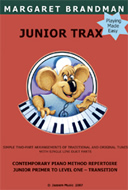 |
Arrangements of young children's favourite tunes from early childhood programs and original songs by Margaret Brandman. Designed to present extra two-handed practice for the first year student. Melodies remain within the five-finger hand position along the white note groups in the keys of C and G. Duet Parts Duet parts are for either a single lower part or obligato melodies complementing the orginal tunes in the higher register of the keyboard. Simple enough for students to play yet interesting for the teacher to play along with the student to develop good reading and rhythm skills. Designed for use a supplementary material to the Junior Primer and during the transition to Book 1A of the Contemporary Piano Method. |
-
The fun way to learn how to bring single line tunes with chords to life, and how to embellish melodies and create your own
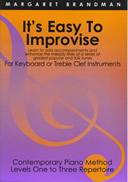
Keyboards and treble clef instruments
The easiest and most enjoyable way to learn keyboard harmony! This book contains graded popular and folk tunes with which to learn left hand accompaniment styles and arranging, plus information on the placement of chords and varying accompaniment styles. It also includes suggestions for melodic embellishment and improvisation applicable to keyboards and single line instruments.
'Margaret Brandman's IT'S EASY TO IMPROVISE takes the mystery out of improvisation by presenting a clearly defined and logical step-by-step method that takes the guess work out of the technique and equips the student with the basic knowledge to improvise in a variety of styles and rhythms. A worthwhile and highly recommended publication that will introduce students to improvisation whilst extending their overall developmental skills and enjoyment of music'
-Rita Crews, AUSTRALIAN MUSIC TEACHER Magazine, Vol 4 No 2 May 1995
|
|
Playing Made Easy for Recorder (Australian edition) -How to play Recorder (USA edition) (contributing author - Catherine Weaver)
"Sixty pages of skillfully prepared instruction and music for the beginner. From 'how to hold the recorder' to Twelve Bar Blues and four-part rounds, it covers a wide range of subjects. IT IS THE BEST TUTOR I HAVE SEEN FOR RECORDER BY FAR. Congratulations to Margaret Brandman with addition of this GEM to her collection." - Neville Thomas, Former Lecturer in Woodwind at Sydney University Conservatorium
"They are the finest collections I have seen on the subject and I recommend them without hesitation." Dr Maurice Hinson. Senior Professor of Music, Southern Baptist Theological Seminary, Kentucky USA
'I congratulate you on the book 'Playing Made Easy for Recorder', with its interweaving of playing techniques and reading skills'. Ann Power - Lecturer in Music Education - University of Western Sydney
|
|
|
Accent on Music - High School Text Book
-
Book and accompanying CD
-
Published by Cambridge University Press.
Contemporary Theory Primer
To be used alongside:
|
|
The page per lesson format encourages the student to move forward at a page a week pace or faster. (Answers included) 'Each subject is covered in such a way as to flood the student's mind with light. Sprinkled throughout are topics never covered except in encyclopaedias, refreshingly and clearly explained in easily understood statements displaying breadth and clarity. They are simply a must for every student and teacher's library.' -Neville Thomas O.A.M., Lecturer in Woodwind Studies, Sydney Conservatorium of Music |
|
-Bruce Clark, jazz guitarist, improviser and music educator |
|
'In her Contemporary Chord Workbook Book 1, Brandman yet again succeeds in making the language, structure and application of modern chords readily accessible to teachers and students........It should be an essential item on every piano student's music shelf.'
- Abe Cytrynowski - ANZCA Examiner, Stretto Magazine - 2002
|
The Contemporary Aural Course
|
Preparatory: 2 x CDs and accompanying workbook and lift-out answer sheet. The Preparatory Course is designed to equip the student from the earliest stages of learning with aural discrimination and the aural skills necessary to hear the music, both with and without the written score.
'Teaching aural work from a student's first lesson is, in my view and that of most music educators, an essential task and one that is now made all the more easy with the advent of this particular publication. The course provides an easy-to-follow and pleasant method of teaching and improving aural skills. In my view it is highly recommended.'
-Rita Crews, MUSIC TEACHERS' ASSOCIATION OF NSW
THE CONTEMPORARY AURAL COURSE Sets 1-8
Set One begins at a basic level and progresses very gradually covering required grade material plus interesting and enjoyable extension work.
'Within each set the material is divided between various musical elements, for example, in Set One the elements are pitch, rhythm and melody while from Set Two onwards these categories are expanded to include cadences and chord progressions.
One of the most useful attributes of this series is the use of review material for revision and reinforcement of work done, which occurs not only at the end of each set, but as the starting points of Sets Two-Seven. Thus there is a satisfying continuity and development which is perceivable by the student as well as the teacher and which helps to increase student self-confidence and feelings of achievement.
Another important attribute is the clarity of presentation. The voice is natural sounding and well-articulated. Students are able to work through the exercises without teacher supervision and at their own pace, and will find the clear enunciation and pleasing tone of voice both encouraging and reassuring.'
-Dr. Helen Stowasser, Associate Professor of Music Education, University of Western Australia
The advanced sets in the series Set 7 (Hear Your Chords!) and Set 8 (Hear More Chords!) deal with the sounds and functions of the chords along with the modes or scales that can be sounded together with them. Each of the sets includes several pieces of music harmonised with modern chords, and requires the student to identify the chord types. Set 8, also covers the sounds of the standard Chromatic chords in classical music the Neapolitan Sixth and the German, Italian and French Sixths.
 Contemporary
Theory series
Contemporary
Theory series 
